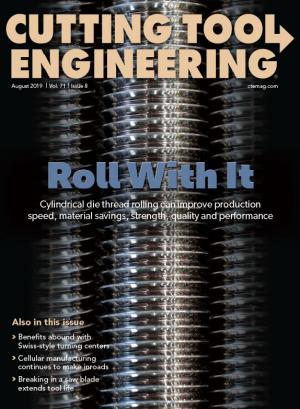Over several decades, precision part manufacturers have adapted to resource constraints, cost pressures and increasing global competition by embracing the principles of lean manufacturing. While lean manufacturing has many tenets, the primary focus is elimination of waste. Cellular manufacturing is one way manufacturers have sought to reduce waste in manufacturing processes.
Cellular manufacturing is no longer an innovative approach to manufacturing as it was a few decades ago. Many large and medium manufacturers have adopted it in some fashion, and automotive manufacturers exclusively utilize it.
Although cellular manufacturing is common, some people may not realize how it has transformed manufacturing and the benefits it provides.

Cellular manufacturing is a broad term encompassing many methodologies and philosophies. It generally combines all manufacturing processes needed to produce a product or family of products into a common area, which allows a person or small team to operate and manage the processes.
A work cell usually houses all processes used in the production of a single part. A good example is my former employer and the individual components it used to manufacture power steering gears. Steering gears are assembled from several major components, one of which is a rack bar. Rack bars are long shafts that must be turned, milled, broached, ground, heat-treated and polished. All these activities are completed in one cell. Bars enter the cell as cut blanks and leave as finished components ready for assembly.
In other situations, a cell may handle one manufacturing process that delivers multiple configurations of the same type of part. Another former employer in the aerospace industry built a cell to machine cast-aluminum flanges. These complex parts required milling, drilling, tapping, reaming and boring. In this case, machining operations were combined into one machine, a horizontal machining center, which allowed a machinist to produce the entire family of parts in one location and in any quantity needed. Prior to installing the cell, flanges had to travel around the shop, stopping at a few different machines, and were processed as a batch before moving to the next machine.
Manufacturing processes in an efficient cell have balanced cycle times so each process is completed in about the same amount of time. Line balance is the term that describes activities used to calculate, plan and build cells with balanced cycle times and efficient flow. When a cell is balanced, products arrive at a rate that satisfies demand with no more or less than is required. This is the foundation of just-in-time manufacturing.
Advantages
A significant advantage of cellular manufacturing is reduced lead time. When parts are manufactured in a balanced cell, the time they spend at a shop before arriving at their destination is dramatically reduced. When parts are processed in a batch, the first part arrives at the same time as the last part, delaying the start of subsequent operations. When parts flow through a cell from one operation to the next, finished parts are delivered as they are completed, creating an even flow of parts rather than arriving in one bundle.
Reduced lead time at a shop results in a reduction of work-in-process inventory. Consider the rack bar example. If 100 parts are needed per day to support assembly, then batch processing would require about 600 parts to be in process at all times—100 at each operation. But if a cell is built that allows operations to be performed one after the other, there will be only six parts in process at any time.
Cellular manufacturing also reduces the amount of floor space needed. Well-designed cells are compact and efficiently consume space. Because they produce less inventory, storage locations are minimized. Reducing the amount of space needed to support production allows construction of smaller spaces and better utilization of existing ones.
Cells provide an ergonomic benefit to shop personnel. Compact, U-shaped cells enable technicians to travel from process to process in a continuous path, minimizing distances traveled during a workday. The cellular design typically permits multiple operations that incorporate many different motions, so the opportunity for repetitive motion injuries is reduced.
Automating processes is easier in a well-designed cell. When the power steering gear manufacturer started making large gears for trucks, we decided to integrate robots into the cells because people would not be able to move the heavier bars by hand all day. Cell layout had been so well refined that integrating robots was easy and required minimal redesign.
Production scheduling also becomes much easier. Scheduling individual machines and processes is not necessary in a cell as each machine is dedicated to a specific operation and nothing else. Planners and schedulers no longer are burdened with scheduling and monitoring individual machines—only the cell must be scheduled. Because parts typically never leave a cell, shops often eliminate the need for routers and travelers.
Cells help close the potential skills gap by reducing complex processes to simple tasks. Efficient cells have capable, robust processes that remove variation. Vigorous processes erase the requirement to have process experts, instead allowing team members to learn specific, critical steps. Centerless grinding is an important operation for rack bar production, and learning the intricacies of centerless grinding can take many years. However, there was no expectation for our rack bar team members to be grinding experts. The workers were expected to master only the few steps needed to produce good rack bars. Proper cellular design simplifies complex tasks like grinding, making it easier to add and train staff.
Cellular manufacturing has become the standard at many organizations and is no longer just for large manufacturers, such as automakers. As manufacturers enter the Fourth Industrial Revolution and are transformed by the internet of things, cellular manufacturing methodology will migrate into every corner of manufacturing.
Related Glossary Terms
- boring
boring
Enlarging a hole that already has been drilled or cored. Generally, it is an operation of truing the previously drilled hole with a single-point, lathe-type tool. Boring is essentially internal turning, in that usually a single-point cutting tool forms the internal shape. Some tools are available with two cutting edges to balance cutting forces.
- centerless grinding
centerless grinding
Grinding operation in which the workpiece rests on a knife-edge support, rotates through contact with a regulating or feed wheel and is ground by a grinding wheel. This method allows grinding long, thin parts without steady rests; also lessens taper problems. Opposite of cylindrical grinding. See cylindrical grinding; grinding.
- family of parts
family of parts
Parts grouped by shape and size for efficient manufacturing.
- gang cutting ( milling)
gang cutting ( milling)
Machining with several cutters mounted on a single arbor, generally for simultaneous cutting.
- grinding
grinding
Machining operation in which material is removed from the workpiece by a powered abrasive wheel, stone, belt, paste, sheet, compound, slurry, etc. Takes various forms: surface grinding (creates flat and/or squared surfaces); cylindrical grinding (for external cylindrical and tapered shapes, fillets, undercuts, etc.); centerless grinding; chamfering; thread and form grinding; tool and cutter grinding; offhand grinding; lapping and polishing (grinding with extremely fine grits to create ultrasmooth surfaces); honing; and disc grinding.
- just-in-time ( JIT)
just-in-time ( JIT)
Philosophy based on identifying, then removing, impediments to productivity. Applies to machining processes, inventory control, rejects, changeover time and other elements affecting production.
- lean manufacturing
lean manufacturing
Companywide culture of continuous improvement, waste reduction and minimal inventory as practiced by individuals in every aspect of the business.
- machining center
machining center
CNC machine tool capable of drilling, reaming, tapping, milling and boring. Normally comes with an automatic toolchanger. See automatic toolchanger.
- milling
milling
Machining operation in which metal or other material is removed by applying power to a rotating cutter. In vertical milling, the cutting tool is mounted vertically on the spindle. In horizontal milling, the cutting tool is mounted horizontally, either directly on the spindle or on an arbor. Horizontal milling is further broken down into conventional milling, where the cutter rotates opposite the direction of feed, or “up” into the workpiece; and climb milling, where the cutter rotates in the direction of feed, or “down” into the workpiece. Milling operations include plane or surface milling, endmilling, facemilling, angle milling, form milling and profiling.
- tapping
tapping
Machining operation in which a tap, with teeth on its periphery, cuts internal threads in a predrilled hole having a smaller diameter than the tap diameter. Threads are formed by a combined rotary and axial-relative motion between tap and workpiece. See tap.


